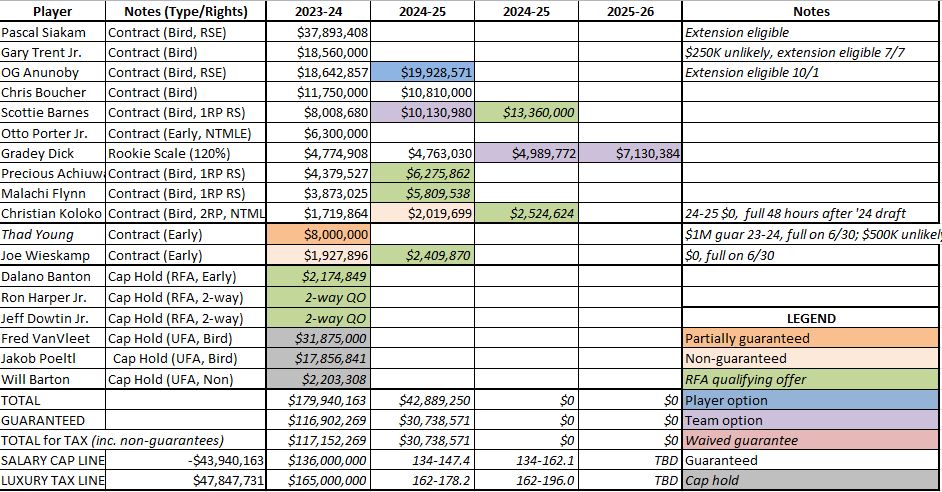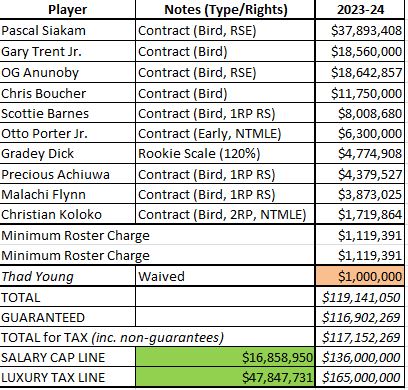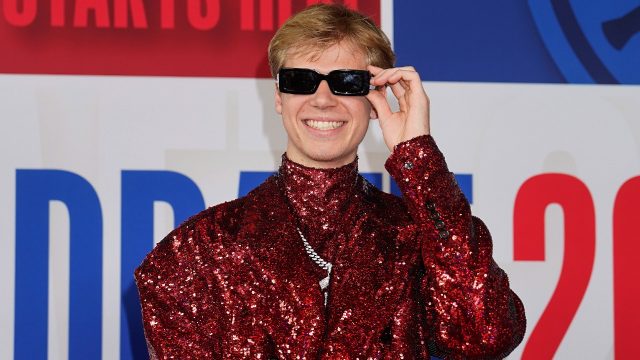Reds beat Braves for 12th straight win as Votto, De La Cruz dominate
As we’re so often guilty of doing, it’s time to quickly turn the page from a very fun NBA Draft night to what’s next.
What’s next for the Toronto Raptors are a number of major decisions in free agency. While a few things have changed slightly since our initial summer primer dropped, the big question remains: In which direction are the Raptors going, and what does that mean for the futures of Fred VanVleet and Jakob Poeltl? The Raptors have given small indications that a run-it-back-adjacent strategy might be likeliest, but those players control their own futures.
Ahead of the June 30 news frenzy, let’s take a look at some of the small changes to the Raptors’ situation that have developed and reset what the free agency situation looks like. I’ll direct you to the full initial primer for explanations of the rules and mechanics; this piece will just update the situation.
Raptors select Gradey Dick at No. 13 in NBA Draft
Who the Raptors picked at No. 13 was unlikely to impact the team’s financial picture. Nearly every player signs for 120 per cent of the rookie scale, so short of the Raptors drafting an international player they would stash overseas, the pick was always going to hit their books with a $4.77 million cap hit.
Raptors opt not to add an extra pick
The Raptors declined to trade or buy into the draft to secure an additional pick on draft night.
While sometimes people equate second-round picks and undrafted free agents of equivalent values, there are two CBA-related reasons why a second-round pick is slightly more valuable.
The first is that a second-rounder counts for his actual salary against the tax, whereas any free agent (even an undrafted rookie) carries the tax charge of a two-year veteran (assuming they make the minimum, a safe assumption for an undrafted rookie). For the purposes of the luxury tax line, your second-round pick saves you an extra $900,000 or so beneath the tax.
The second is the new CBA includes a second-round pick exception, allowing you to sign your second-rounder to long-term contracts more freely than an undrafted free agent. Previously, any second-round or undrafted rookie was capped at a two-year contract unless a team used cap space or one of their exceptions to sign them to a longer deal. That remains true for undrafted rookies, but second-round picks can now be signed for up to four years without dipping into their exceptions.
This isn’t a huge deal. For a team trying to get back to finding and developing young talent at an elite level, and for a team trying to navigate an off-season tight to the luxury tax line, it’s a little bit of a deal.
As an aside, the Raptors did not use the $6.36 million in cash they’re allotted to include in trades for the 2022-23 league year (that’s not uncommon, this is just a procedural note). That amount resets on July 1, with a 2023-24 cash allotment of $7 million.
Trent picks up option
Gary Trent Jr. picking up his player option for the 2023-24 season was a minor surprise, given how thin the free agent class looks and what players like Trent tend to earn. Even declining the option to sign a multi-year deal at the same annual value would have been justifiable, securing Trent significantly more guaranteed long-term money.
Instead, Trent will make $18.56 million this year and either become an unrestricted free agent in 2024, work out an extension (he is eligible to do so July 7, and the new extension rules make it far likelier than it would have been under the old CBA), or become a potential trade piece as contenders look to add young shooting.
Trent opting in is a positive for the Raptors in terms of their 2023-24 cap sheet situation, as the $18.56 million cap hit (with $250,000 in unlikely incentives) is less than we would have expected Trent to secure on a new deal.
If the Raptors are trying to re-sign Trent, VanVleet and Poeltl, doing so and staying beneath the tax is a little easier with Trent’s decision locked in.
VanVleet declines option, Porter picks his up
We’ve long expected Otto Porter Jr. to pick up his $6.3 million player option for 2023-24, which he did shortly before the initial primer came out. He’ll now add the veteran shooting depth it was hoped he could add last year (assuming he’s healthy), with a relatively low cap hit. With Porter’s money, it’s more about opportunity cost and space beneath the luxury tax, to the extent I’d imagine the Raptors at least ask around the league if anyone is interested in a vet with championship experience on an expiring deal.
VanVleet declining his $22.82 million player option was also a near-certainty. He slides in near the very top of the free agent class, and while the Raptors will have every chance to re-sign him, he’ll be a popular target of contenders in sign-and-trade scenarios.
It’s also worth noting some teams could make a play for VanVleet without sending out assets in a sign-and-trade simply by clearing cap space. Some of the cap-space teams might not make sense, timeline-wise, but a few teams on the fringes have the flexibility to manoeuvre into cap space if necessary.
VanVleet is unquestionably the biggest swing piece in Toronto’s off-season, whether as a win-now piece to keep or as someone who can return real assets on his way out. Losing a player of VanVleet’s calibre for nothing in a straight signing scenario would be difficult to recover from, from an asset-management standpoint.
New salary cap and luxury tax lines
The NBA updated the salary cap and luxury tax lines for 2023-24 this week, and they’ve come in higher than even the robust initial protections. The most important number for the Raptors is the luxury tax line jumped from $162 million to $165 million.
For a team that was going to be razor-close to paying into the luxury tax just by retaining their free agents — before using the mid-level exception or adding through other means — that extra $3 million in wiggle room is meaningful.
And yes, the Raptors can spend into the tax, they have just chosen not to do so in the past unless they were in a title contention situation. The real-money impact can be significant, as non-tax teams this year received an estimated $15 million each from tax-paying teams. It’s a situation where you don’t avoid the tax at all costs, but if you’re close, you may as well do what you can to stay beneath it.
Teams can also enter the season above the tax and get under it later; your tax charge is based on your cap sheet on the final day of the season, not the start of the season.
New exception amounts
With the cap and tax going up, the value of exceptions has also increased.
• Bi-annual exception: $4.51 million first-year salary, up to two years and $9.25 million total
• Taxpayer mid-level exception: $5 million first-year salary, up to two years and $10.25 million total
• Room mid-level exception: $7.72 million first-year salary, up to three years and $24.32 million total
• Non-taxpayer mid-level exception: $12.4 million first-year salary, up to four years and $53.33 million total
Those exceptions can be split between multiple players. In the new CBA, those exceptions can also be saved to acquire a player via in-season trade. They cannot be combined with other exceptions or with players.
The Raptors situation
The Raptors have $115.9 million committed to 10 players right now, plus $1 million guaranteed to Thaddeus Young and a non-guaranteed deal for Joe Wieskamp.
Young’s contract would become guaranteed for $8 million if he’s still on the roster past June 30. Now that the draft has passed without Young being used in a trade, the likeliest scenario is the Raptors waiving him in the next week and eating the $1 million he’s owed.
Wieskamp would be owed $1.93 million if he remains on the roster past June 30. That’s roughly the amount of a two-year veteran minimum, so this is mostly a question of roster flexibility. My guess would be the Raptors waive Wieskamp and, if his camp is willing, re-sign him to a new deal with a different guarantee schedule, allowing Wieskamp to develop in the system over the summer and compete for a roster spot in the fall.
There are also qualifying offers to be extended to Dalano Banton ($2.17 million), Jeff Dowtin Jr. (two-way), and/or Ron Harper Jr. (two-way) by June 29. Those players would become restricted free agents if given the qualifying offer and unrestricted free agents if not.
For the sake of simplicity, the following graphic assumes Young and Wieskamp are waived. We’ll put the RFAs off to the side for now, as well.
The first thing that should stand out here is even if we remove all of the Raptors free agents, the team would only have $17 million in cap space. That’s a scenario with no rights to re-sign those players and nothing coming back in any sign-and-trades. Because that amount is so small — barely above the mid-level exception — the Raptors will operate as an above-cap team, keeping the rights to their free agents and opening up the mid-level exception.
The more important number is $47.85 million, the space the Raptors have beneath the luxury tax right now.
If the Raptors don’t want to nudge into the tax, that’s the number they have available to re-sign VanVleet, Poeltl, any mid-level target, any undrafted rookies, Dowtin, and so on. You have to have at least 14 players under NBA contract, so the maximum for just VanVleet and Poeltl, assuming the roster is filled out with minimum contracts and they leave one open roster space, is $43.8 million. That would drop to about $42 million if they planned to use a 15th roster spot throughout the year.
Teams are allowed to back-load contracts to a small degree, offering the Raptors some additional flexibility. For example, if they wanted to get VanVleet and Poeltl for $42 million total, they could offer Poeltl a three-year, $55.1-million deal and VanVleet a four-year, $112 million deal and have them for starting salaries of $17 and $25 million. That example gets you both players for $42 million in 2023-24 salary despite the average salary being $46.4 million. That example also, again, includes no use of the mid-level or signings beyond the minimum. So use the $42 million number carefully.
Trades (and sign-and-trades) can change the outlook here fairly quickly. For now, the off-season’s headline item is “$42 million beneath the tax for VanVleet and Poeltl, plus minimum contract guys, barring trades.” There’s a world of creativity beyond that — in either franchise direction — but it’ll be our starting point for June 30.











